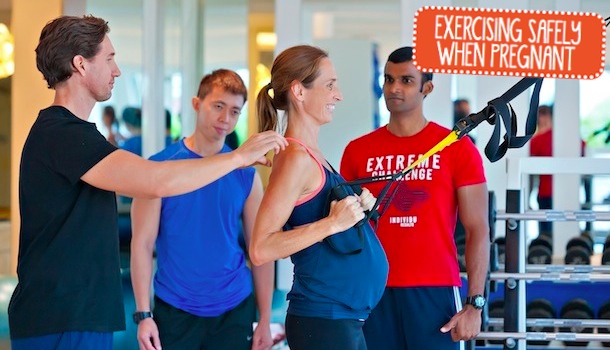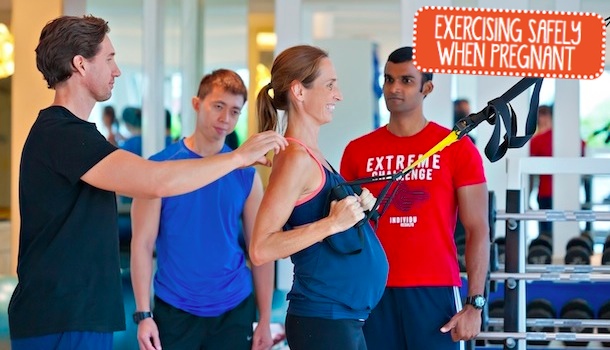
 Post Category - WellnessWellness - Post Category - HealthHealth - Post Category - FitnessFitness
Post Category - WellnessWellness - Post Category - HealthHealth - Post Category - FitnessFitnessWhile being pregnant may feel like a workout in itself, remaining active during pregnancy can be just as tough! To help us through, we turned to resident personal trainer (and all round nice guy!) Aaron Rolley of IFC Personal Training to get his advice on how to exercise safely during pregnancy — we even asked him which exercises will help with those post-baby aches and pains!
Q1. Is it safe to exercise while I’m pregnant?
Before starting any exercise programme (particularly while pregnant!), it’s important that you get clearance from your doctor first. If you were exercising before you were pregnant and you’ve been given the green light from your doctor, then I would say exercising is not only safe but also beneficial!
By exercising regularly whilst pregnant, it can help keep your blood sugar in check (thereby reducing your chance of developing gestational diabetes) as well as helping you to look and feel better. Childbirth is often compared with running a marathon, so by staying fit it helps make the pregnancy and the delivery that bit easier.
Q2. What guidelines should I be aware of if I want to continue exercising while pregnant?
You should always check with your doctor first for the latest information and recommendations. Having said that, while some recommendations may vary from doctor to doctor, I have found the following pieces of advice have remained the same…
- Be sensible – if something doesn’t feel right, hurts or seems too extreme, don’t do it! Everyone is different so it’s important to listen to your body.
- Don’t push it too hard – you can still huff and puff a bit, but your training should be about keeping you healthy and feeling good not about going for new personal records. At various times during your pregnancy your body may need extra rest and sleep (for many this is particularly so in the first trimester and towards the end of the third trimester), so these are not the times to be pushing a heavy exercise agenda.
- Don’t overheat – it’s very important for all soon-to-be mums living in Singapore!
- Stay hydrated – your body needs even more fluid at this critical time so it’s important you drink plenty of water.
Q3. Are there any exercises that I should (or shouldn’t) be doing now that I’m pregnant?
I find that the foundation exercises, like squats, lunges, overhead presses, rows and dips, all work well during pregnancy. These exercises can be done with either a moderate weight or, as the pregnancy progresses, with body weight alone.
Pushups and planks tend to be well tolerated as well, however as the baby gets bigger some may start to feel the abdominal wall strain when in a prone (face down) position. If this happens then it’s best to stop these movements until after the little one arrives.
Lastly, no abdominal crunches! Different versions of the basic plank are great for keeping the core muscles strong during pregnancy, but always stay away from crunches.
Q4. Are there any exercises in particular that will help once the baby is born?
Many new mamas have problems with reduced abdominal tone after giving birth, upper back aches (too much hunching while breastfeeding) and poor posture (too many hours carrying a baby around!). While some mums are super keen to get back into the gym after giving birth, I find taking a slow and sensible approach much better.
The foundation exercises mentioned above are a good starting point, as they target all the important areas for new mums. They help to tighten up the abdominal area (we generally avoid crunches for a good while) and strengthen the postural muscles, while still shaping the important buttocks, legs and arms.
Q5. What is foam rolling and why is it useful for pregnant and new mamas?
Foam rolling is essentially a form of self-massage that releases muscle tightness and improves blood flow, all by using a simple foam roller. It’s especially useful for pregnant women and new mums as it can help relieve some of the general aches and pains of pregnancy, as well as helping with conditions like sciatica (which can be relieved with a bit of strategic rolling!).
Q6. How do I use my foam roller correctly? What exercises should I be using it for?
There are a few different ways to roll, and we’ve seen benefit from all the versions we’ve tried. You can use a foam roller to roll along the entire length of your muscle, going up and down 5 or 6 times, stopping on any sore spot and holding for a few seconds before moving on.
As a general rule you want to focus on the big muscles that are most prone to tightness, like the calves, the IT band (not actually a muscle), the buttocks, the thighs (front and back) and the chest muscles.
You can’t really go wrong with foam rolling, although to get the most out of it, it’s best to get a qualified trainer to show you how to do it first.
Fabulous photos by the very talented team at Tomato Photo. Contact them by emailing [email protected].
Aaron Rolley has a degree in Sports Science and has been personal training for almost 20 years. As the founder of IFC Personal Training, Aaron is renowned for his approach to building fitter, stronger, and leaner bodies in a fun and safe environment. You can contact Aaron at (+65) 9431 7880 or at [email protected].






 View All
View All





 View All
View All








 View All
View All










